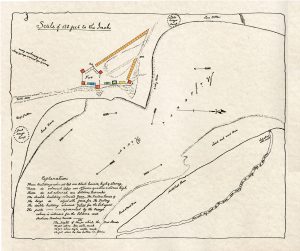
Built under the direction of General William Clark, joint commander of the famous Lewis and Clark expedition, Fort Osage was established in 1808 as a military outpost in the newly acquired Louisiana Territory. The Fort’s purpose was to provide a military presence in the territory in order to assure Spain, France and Great Britain that the United States meant to protect its territory by military strength and to establish healthy relations with the Native American population in the territory.
Fort Osage was built on a strategic bluff overlooking the Missouri River. The height and location of the bluff provided a clear view of the river for many miles and the river current around the bluff caused the boats to slow down considerably in order to safely navigate. These conditions provided a natural defense for the Fort.
“Rose early, examined the Situation and the points of a Small Island which is opposit, found the River could be completely defended and Situation elegant, this Situation I had examined in the year 1804 and was delighted with it and am equally so now, ordered the Boats to be unloaded and tools got ready to work, and fixed on the spot for the fort and other buildings…”
—William Clark, Monday 5th Sept. 1808

At the time of establishment, the Fort had a company of 81 officers and enlisted men under the command of Captain Eli B. Clemson. The soldiers enlisted for a minimum of five years service and were paid $5.00 a month depending on service and rank. The soldiers performed military drills and duties for most of the day. Extra duty was also required of each solider at the Fort. This extra duty was performed during their free time, and they were paid 10 cents a day for common labor and 16 cents a day for skilled labor. A soldier’s daily rations included one and a quarter pounds of beef or three-quarters pound of pork, 18 ounces of bread and one gill of rum, whiskey or brandy. They were issued salt for their food, candles, and vinegar.
The factory system in the United States was established in 1796 under President George Washington and expanded by President Thomas Jefferson into the Louisiana Territory. The factory system derives its meaning from the English common law definition of a factor as a person who buys and sells on behalf of his employer. The purpose of the factory was to trade quality goods at a low price with the Indian tribes in order to establish good relations with them. The system practiced by private European and American fur traders seemed to be a constant contributor to unrest in the territory. It was Jefferson’s hope to undermine the private traders and gain Indian alliances for the United States.
George Sibley was the factor at Fort Osage from 1808 until 1822. His duties included bookkeeping, supervising the trade room, processing furs, stocking trade room and attending to Indian affairs. Sibley was paid an annual salary of $800 until 1811, when he received a raise of $300. This salary can compare in today’s economy of around $90,000 a year.

The United States factory system was discontinued by Congress in 1822 due to pressure from the rival fur trade interests. The decline of the United States factory system was due to a number of reasons: The lack of factors familiar with Indian trade, government regulations and budget restrictions, which hampered any effort to increase the trade, lack of incentives for the factor, successful competition of private traders who could go to the Indian villages instead of the Indians coming to them, and the influences of European traders in the remote regions of the country.
The military left Fort Osage in 1813 due to the War of 1812. It then returned in 1815 to re-establish the military garrison. The military left Fort Osage again in 1827 when Fort Leavenworth was established.
Fort Osage has been partially reconstructed and is currently a park owned and operated by Jackson County Parks + Rec.